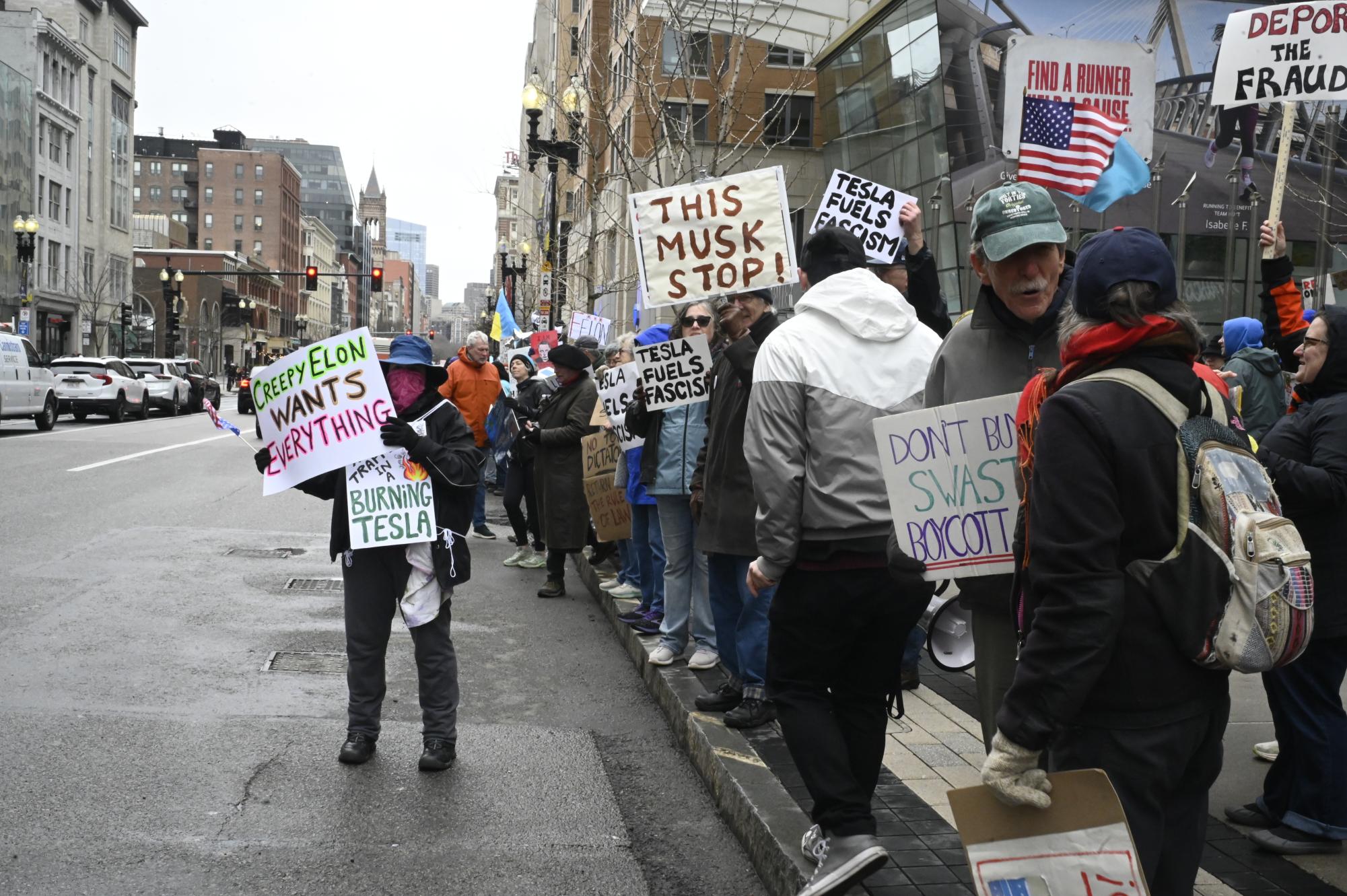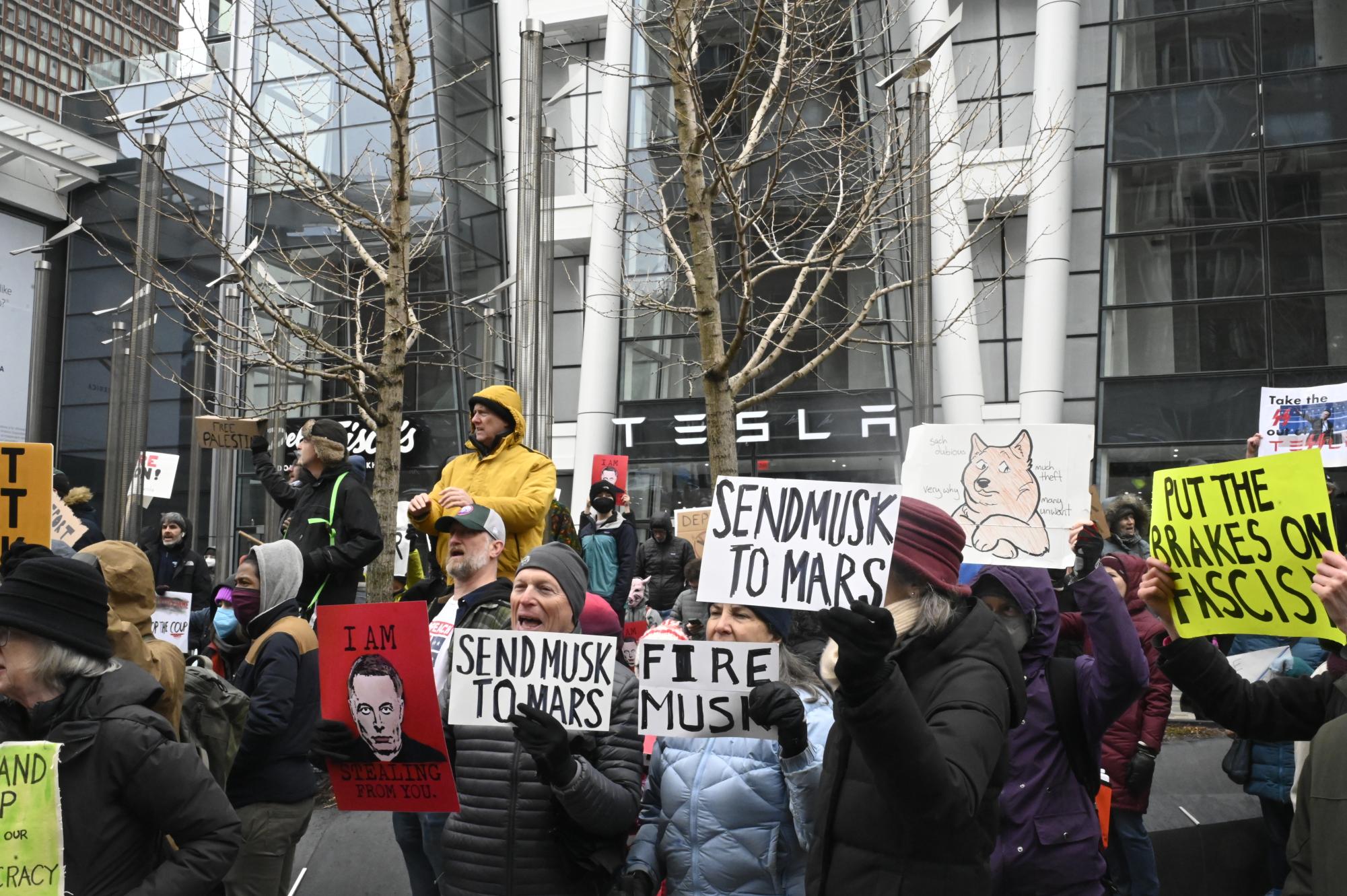Over 600 people gathered outside the Tesla showroom in the Prudential Center on March 29 to participate in the global тАЬTesla TakedownтАЭ movement.┬а
The crowd outside the Prudential Center was one of over 200 nationwide demonstrations. The movement, which began as a scattered and small group, started after President Donald Trump was inaugurated in January and DOGE was officially implemented. Saturday served as a тАЬglobal day of actionтАЭ and had the largest crowds outside Tesla showrooms and service centers.┬а
Recently, the Department of Government Efficiency, spearheaded by billionaire and Tesla CEO Elon Musk, has been responsible for the gutting of several government agencies, including USAID and the Department of Education, and the firing of over 120,000 federal workers.

Now, people have been gathering on Saturdays outside of the Tesla showroom in the Prudential Center for six weeks. Since the first event, the crowds have grown exponentially, according to two of the primary organizers, Shua Sanchez and Heather Johnston, both Boston residents.┬а
тАЬThat Saturday, there were only a few dozen people, and I thought there should be a lot more people,тАЭ said Johnston. тАЬSo I got the contact info of some other people who were there, and we all have been trying to get more people to come since.тАЭ┬а
Through the use of social media platforms like BlueSky, local media, and word of mouth, the movement began to grow. Saturday served as the largest protest yet, despite the cold weather.┬а
тАЬSix weeks ago we had 10 people, two weeks ago we had 100 people,тАЭ said Sanchez. тАЬLast week we had 450 and this week we have 600.тАЭ┬а
The Tesla Takedown Movement serves a dual functionтАФorganizers are also calling for a boycott of Tesla. Their website urges participants to тАЬsell your Teslas, dump your stock, join the picket lines.тАЭ┬а
The group hopes to intensify a recent decline in the companyтАЩs sales, and MuskтАЩs primary income source. This year, Tesla shares have lost 50% of their value, and stocks have plummeted 36%.┬а
тАЬWe’re making it very normal to oppose the regime, and then we’re also doing this direct economic action against Elon Musk, where we’re picketing the Tesla stores and encouraging people not to buy Teslas. And that is weakening Elon Musk,тАЭ said Johnston.┬а

Throughout the protest, Johnston and Sanchez led the crowd in chants with their megaphones, such as тАЬHey hey, ho ho, Elon Musk has got to go,тАЭ and тАЬDemocracy is under attack. What do we do? Stand up, fight back,тАЭ which were magnified by a live brass band.┬а
Many people waved signs such as тАЬHonk if you hate ElonтАЭ and тАЬWe the people are pissed.тАЭ Several others equated Musk to a Nazi, following his problematic hand gesture during a speech after TrumpтАЩs inauguration in January.┬а
The two-hour protest remained peaceful and lighthearted. Some people danced while the band played. As cars drove by, many honked in support as protesters cheered back.┬а
Ryan T., who declined to share his last name, said it was his third time protesting against Musk. As he danced outside the showroomтАЩs doors, he expressed optimism about the movement.┬а
тАЬI think nonviolent demonstration is really important for winning over people who are upset but not out in the streets yet,тАЭ he said. тАЬIt doesn’t take a huge proportion of the population to compel peaceful change at the upper levels.тАЭ
To make sure the protest remained peaceful, volunteers called тАЬpeacekeepersтАЭ ensured that walkways were clear and conflicts did not arise. Many handed out brochures with future protest information, or a list of MuskтАЩs recent actions that inspired the movement.┬а
Kate, who did not share her last name, is a longtime volunteer who shared her anxieties with TrumpтАЩs administration.┬а
тАЬIf we lay down, if we don’t stand up to this, we are going to be living under fascism,тАЭ she said. тАЬ[Protesting] is vital.тАЭ

For many, the weekly protests serve as a way for them to find community amid anxiety surrounding the current political climate.
тАЬWhen we’re all suffering together and so scared and fearful, that’s when you find community, you find courage, you find strength, and that is pretty powerful,тАЭ said Katie, who declined to share her last name, a volunteer with Indivisible Massachusetts Coalition, an activist group focused on improving democracy.┬а
Katie also shared her disdain for Republican supporters who have enabled what she said was TrumpтАЩs more controversial legislation, like cuts in DEI and his immigration policies. She also praised public officials who have been staunch in their opposition to Trump.┬а
тАЬProtests like this also give indication to the judges and our senators and congresspeople that are working so hard for us that we really care, because as tired as we are from all this, public servants must be exhausted,тАЭ she said. тАЬAnd they need us to show them that we’re here for them, and we’re gonna keep fighting and we’re gonna win this.тАЭ┬а
As the event began to wind down around 2 p.m., Sanchez led the crowd in chants and stated that they would resume the usual protest the following week. In an interview, he shared that he hopes the movement will continue to grow.┬а
тАЬThe more people that come to these things, the more effective that they are,тАЭ Sanchez said. тАЬAll you gotta do is show up and make your voice heard.тАЭ